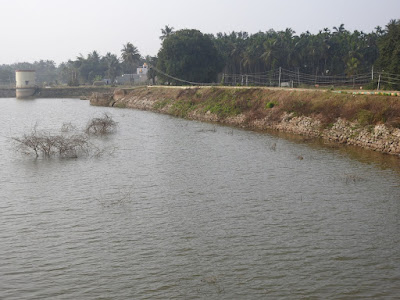...continued from Sri Maha Ganapati Devastana and Sri Beteraya Swami Devastana. Just after seeing Beteraya Devastana, we learned about Ishwara Devastana. another ancient temple a two-minute walk away. The temple literally the northeastern corner of the village. Also the temple site is situated right besides Gulur Kere bund. This is the Shivalaya, it's ancient but it has almost lost it's original form. Thanks to the maintenance work with modern material. Anyway, one has to admire the villager's will to preserve this temple.
The temple's yard is occupied aby an ancient Peepul tree, a Banni tree, a Neem tree and few banana plants. The temple gates were locked and inner doors were shut. I think this temple gets visitors once a week i.e. on Shiva's day Monday.
We step out the temple premises and climb the tank bund steps. This is the view of the Shivalaya from the bund. The curved wall seen here also seems ancient, may be a hundred years old. I guess it was built when Gulur Kere bund underwent maintenance. Originally this Shivalaya sat on the lake shore. A bund was built to increase the lake's storage but the temple was left as it is. The engineers put a retaining wall instead of earthen bund. Thanks to the engineers for preserving this holy place's sanctity.
Taking a few steps backwards, the Shivalaya's Stambha comes into view. Only the Stambha has been removed and fixed at a slightly elevated position. The Stambha design and texture gives a clue of it's age. I'm guessing it's around 500 years old i.e. Vijayanagara period.
Also there's an idol of Nandi seated on a pedestal. This Nandi idol is similar in looks & size to the pair of Nandi marking the ancient entrance of Gulur i.e. near Beteraya Devastana. That's my friend Sridhar, from here we could be heading to his farm in Bhogasandra village.
In the background is a walled enclosure which evoked curiosity. Inside the enclosure are rows of stones fixed into the ground.
The enclosure is called Nagara Katte which literally means serpents' platform. Almost all ancient temples had a raised platform dedicated to serpent idols. Also on the platform would be a Peepul tree. Somehow here we have a huge plot dedicated to Naga stones. According to the stone plaque on the wall, this place was reconsecrated on June 18th 2008.
At the far end of the enclosure are larger stones with faded sculptures of serpents i.e. Nagas.
Lastly, before I close this post, a view of Gulur Kere. This waterbody is quite big, about 1500m long and 600m wide. I guess this is one of the sources of water for Gulur village.
Done with Gulur village for the time being. From here we head towards Kaidaala to see Sri Chennakesaava Devastana. It is said that Kaidala is the legendry sculptor Jakanachari's hometown.




















No comments:
Post a Comment